New York Rangers: Five decisions that are coming back to haunt them

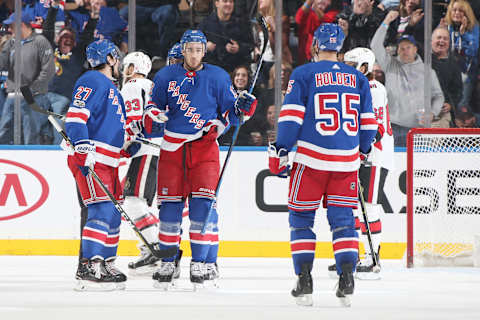
While the New York Rangers have seen recent success, they are still seeing the impact of poor decisions that have been made over the last few seasons.
After a rough start to the season, The New York Rangers have seemed to find a balance in their offensive and defensive game. They picked up momentum, winning nine of their last 12 games in the month of November.
However, there are still underlying issues that the Rangers still need to navigate.
These problems are a direct result of decisions that were made by management over the last few years.
While some have stemmed from decisions made on the roster this season, others have been so incessantly employed that they are pretty much expected. While some relate to this offseason, others stem from contracts signed years ago.
Regardless, they will need to be attended to if the Rangers hope to see success.
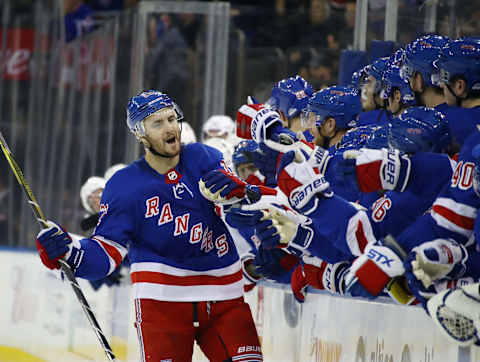
#1: Splitting up McDonagh and Shattenkirk
Putting Ryan McDonagh and Kevin Shattenkirk on separate lines is a decision that has impacted the New York Rangers in nearly every game this season.
Shattenkirk was one of most talked about free agents this offseason. His decision take a salary cut to sign in New York made headlines. It was expected that upon his arrival in New York, he would play with Ryan McDonagh on the top pair.
Shattenkirk is an NHL veteran with great offensive ability. Being paired with a player like McDonagh who is very responsible yet who also encourages offensive opportunity, would have made for an offensively dangerous, yet defensively effective top pair.
Alain Vigneault experimented with the pairing early in the year, but after the Ranger’s slow start, he quickly labeled it as a part of the problem and shuffled the defense around.
Shattenkirk has been paired with Brady Skjei, which is by no means a bad fit. It is, however, a dangerous situation for his young defensive counterpart.
With McDonagh out of the lineup for the past few games, there are obviously deep-rooted problems with the defensive deployment. But despite an unsteady structure at the moment, Vigneault has shown he can’t determine what is best for his team.
He has not effectively used the assets he has available and this is something that needs to change — otherwise, the Rangers inconsistency will continue.
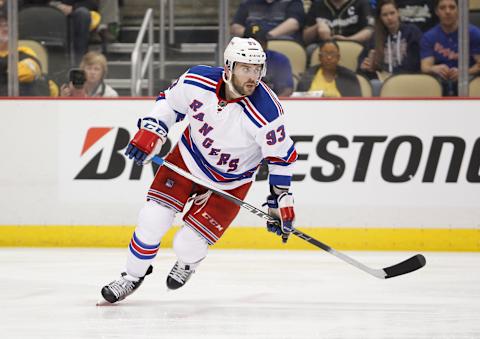
#2: Moving talented players and getting next to nothing in return
The trend that we could potentially see continue with the Derek Stepan trade is nothing new for the Rangers. There have been multiple cases in the last few seasons where the Rangers gave up valuable pieces and have seen little return.
Carl Hagelin, Cam Talbot, and Keith Yandle are all names that come to mind.
The Rangers traded Hagelin and two picks (#59 and #179 of the 2015 draft) to the Anaheim Ducks for Emerson Etem and the number #49 pick (also from the 2015 draft). Etem did nothing for the Rangers, they traded him just a season later and Hagelin went on to win two Stanley Cups with the Pittsburgh Penguins after being dealt at the 2016 trade deadline.
The Rangers traded Cam Talbot to the Edmonton Oilers in the same offseason as Hagelin (they also gave them a seventh-round pick). In return, the Rangers received for just three picks.
Yes, Talbot is a backup. However, his numbers say that he easily could have brought in a bigger return.
Keith Yandle was sent to the Florida Panthers for a sixth-round pick in the 2016 NHL Draft and a 2017 conditional fourth-round pick after just one full season on the Rangers roster. Two picks in return for a player who led the team with 42 assists and had 47 points (fourth highest on the roster).
The Rangers also gave up a promising young prospect in Anthony Duclair to get Yandle to New York. Essentially, the Rangers gave up Yandle, Duclair and two picks for a season and a half of a bottom pair defenseman, along with a handful of young players who may or may not make the roster.
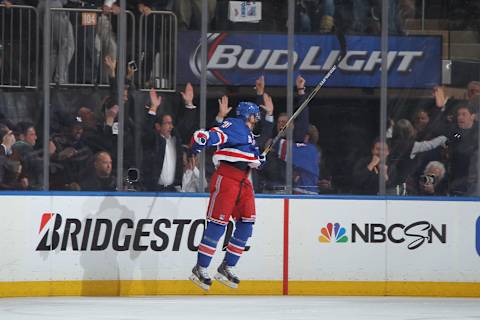
#3: The Stepan Trade
We have been talking about how the loss of Stepan has hurt the team all season. Despite Zibanejad’s success in taking over the first line center position, the Rangers have struggled with their center depth throughout the rest of the roster.
Beyond this, there are a few other glaring issues that have not been as widely discussed.
The Rangers lost Antii Raanta in this trade too. Raanta was stellar in net last season in times when Henrik Lundqvist struggled. He absolutely deserves a starting role on a team, which was likely clear to the Rangers’ front office.
However, their decision to lump him into the Stepan trade is questionable. Why didn’t management consider re-signing him and trading him for a larger return? (In light of all of the teams who are in need of a goaltender at the moment, this would have been a great option).
This only furthers the support of the aforementioned trend that we have seen with the Rangers moving assets.
Trading a number one center and a starting goaltender for a prospect (who will likely be a number two center at best) and a young defenseman (who is known for his offensive game yet has just one primary point since being sent down to the AHL) is just bonkers.
The Rangers have been digging themselves into a hole and these decisions will impact their future. Maybe not now, but soon.

#4: Awful personnel management
The fact that players like Paul Carey, David Desharnais, Nick Holden, and Steve Kampfer are getting ice time when the Rangers have a plethora of young talent in their system right now baffles me.
You would think that based on the Rangers current struggle with depth down the middle that Vigneault would be searching for any player that could add value. It seems ridiculous that Carey and Desharnais have been the answer.
Each recorded a 0% (ZERO PERCENT) Corsi-For in Sunday’s game against Vancouver. Meanwhile look at prospects like Vinni Lettieri and Filip Chytil who are having impressive seasons in Hartford. Why not toss them in and give them a shot to expedite their development?
And there is a similar trend with Holden and Kampfer. The two have not been adding nearly as much value as they need to be to be playing as much as they have.
Luckily, the Rangers have even more options when it comes to defensive prospects. With players like Ryan Graves who have some professional experience to guys like Neal Pionk and Sean Day– two newbies to professional hockey — the Rangers future is bright.
It is time for the Rangers to take advantage of these resources. Their use of their veterans has not always worked in their favor.
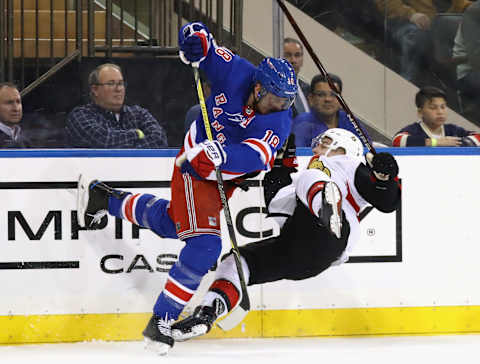
#5: Signing Staal and Girardi to long-term contracts
Finally, the choice to extend the contracts of Marc Staal and Dan Girardi have slowly become the stem of the team’s defensive problems.
Both Staal and Girardi were playing well enough when they inked these contracts. However, both signings were risky. Due to the length of contracts and each players age, the Rangers needed production from the two veterans to make them worth their paychecks.
Each saw a drop in their production almost immediately and soon became problematic in their roles on the roster.
Girardi was solid in his positioning and puck blocking ability throughout his career. However, his play in nearly every other area of the ice severely hurt the Rangers last season. Putting Girardi on a pair with Ryan McDonagh gave their captain an unnecessary amount of pressure to make up for his shortcomings.
In his prime, Marc Staal was able to make an impact every game. Today, he still does, but now it’s negative instead of positive more times than not.
While his play has been better in recent weeks, Steve Kampfer does not give Staal the skill nor the possession driving support that the Thunder Bay, Ontario native so desperately needs.
Next: Five predictions for December
Terminating Girardi’s contract was the right choice. Considering doing the same with Staal could have saved Stepan and the Rangers’ offensive depth. But here we are instead…